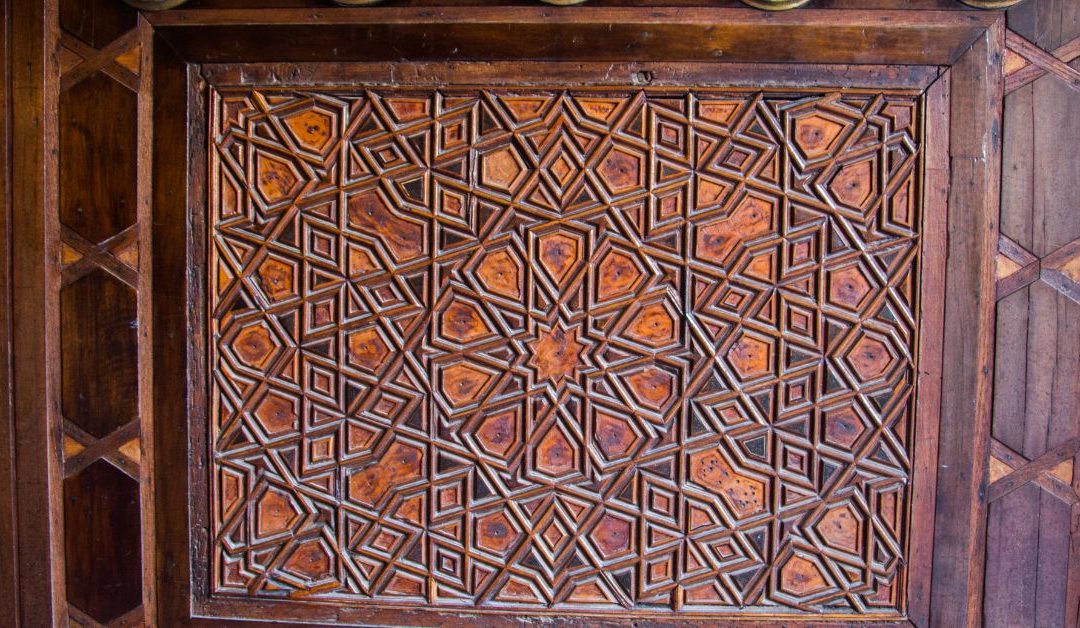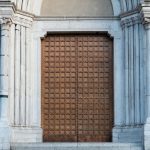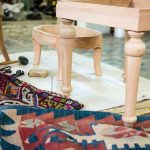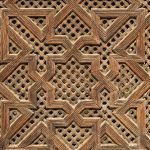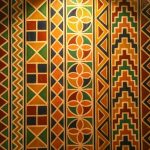Islamic art has influenced traditional Moroccan woodworking for many centuries. In Moroccan woodworking, they use designs from Islamic art like shapes, writing, and patterns to make things look pretty and unique. The furniture pieces, such as tables and chairs, showcase these artistic influences.
Moroccan woodworking often features religious symbols like stars, crescents, and other spiritual figures. These symbols are visible in many examples of Moroccan woodwork. The vibrant colors used in these artworks enhance their beauty.
In summary, Islamic art has had a profound impact on Moroccan woodworking. It has shaped the craft by incorporating geometric shapes, calligraphy, and abstract patterns. Religious symbols are prevalent in these works, and the use of vibrant colors further enhances their beauty.
Overview Of Islamic Art
Islamic art has always been creative and ingenious. In Morocco, they use it to make beautiful things out of wood. The art includes floral designs, geometric shapes, and even animals or plants. This style has influenced Moroccan culture for centuries, and you can see it in their furniture, cabinets, and doors. Woodworkers in Morocco use traditional ways to create pieces from cedarwood and other materials. These pieces capture the charm and personality of Moroccan life. Nowadays, you can see Islamic-inspired artwork all around Morocco.
Geometric Shapes
Islamic art has influenced Moroccan woodworking. They use tribal patterns, geometric tiles, and other elements of Islamic design in making furniture and home decor in Morocco.
Geometric shapes play a big role in this art. People use geometric shapes to create repeated patterns, borders, and compositions. People use shapes like squares, triangles, and hexagons. People use squares to make shapes that repeat over and over again and to create borders around things. They use triangles to make things look balanced and even, like when they connect lines at different angles. And they use hexagons in mosaics, which are like pictures made out of small colored tiles, to make colorful and bold designs.
The use of geometry in Islamic art is symbolic and represents harmony between humans and gods. Each shape is then placed to convey balance, peace, and spirituality.
Next, we will see how calligraphy adds to these artworks through written language.
Calligraphy
The geometric shapes of Islamic art influenced woodworking in Morocco and still do today. They also use calligraphy, which is fancy writing, in their woodwork. Calligraphy adds color and texture to furniture and other things. This style of decoration has been around for a long time and started as decorative writing on pottery, coins, and buildings. In Morocco, artists made it even better and unique.
These days, people still love calligraphy because it’s beautiful and meaningful. Each piece, whether it’s a single word or a whole phrase, tells a story about the culture, history, and faith of the people who made it.
Islamic art inspires woodworkers all over the world today. Next, we will talk about abstract patterns.
Abstract Patterns
Islamic art has influenced Moroccan woodworking with its intricate abstract patterns. These designs include floral motifs and geometric shapes, showing traditional culture and heritage.
- Here are some examples:
- Wooden boxes with detailed lines carved into them.
- Tables with beautiful flower details.
- Panels with calligraphy that feature symbolic designs.
People of all ages and backgrounds admire these works of art for their timeless beauty and elegance. Craftsmen have been using techniques for hundreds of years to create special pieces that show the rich history of Morocco. These modern craftsmen still make unique artworks that capture the culture of Morocco.
Islamic art has influenced woodworkers worldwide, shaping their sense of aesthetics. Now, let’s explore religious symbols.
Religious Symbols
The religious symbols of Islamic art have had a significant impact on Moroccan woodworking. These symbols appear in many forms, from poetic verse to sacred imagery. They narrate the story of a rich culture and tradition that generations have passed down.
By examining these symbolic elements, we can appreciate how people use them to express their spiritual beliefs. A table summarises some of the common religious symbols found in Moroccan woodwork:
| Symbols | Meaning | Example |
| Quranic Verse | Divine guidance | “Verily Allah is with those who fear Him” (Quran 9:18) |
| Stars & Moons | Protection against evil forces | Crescent moon carved into doorways and window frames |
| Calligraphy | Praise of the divine creator | Arabic phrases such as “Alhamdulillah” or “Allahu Akbar” inscribed onto furniture pieces |
Looking at examples like these shows that Islamic art is very important in Moroccan woodworking. It’s not only about how it looks, but also about its meaning and symbolism. This style has a big impact on design choices even now. As we learn more about Islamic art in Morocco, let’s remember the connection between religion and craftsmanship.
Stars
In Islamic art, stars are special and represent the divine. They show that things go on forever and ever. Moroccan carpenters use stars to make pretty designs that remind us of our connection to the universe. There are stars with two points or stars with eight points, but they all remind us that we are all connected to each other.
- Stars symbolize guidance for humanity;
- They signify hope when things seem bleak;
- And they inspire us with their vastness and beauty.
You can see heavenly symbols in Moroccan woodworking, like starburst designs on carved doors or single points on archways. This tradition stayed through generations, showing that we can all reach our best with God’s grace.
Next, crescents are another important symbol used by artists to show respect for spirituality and faith in Islam.
Crescents
Islamic art has a strong influence on Moroccan woodworking, especially in the use of crescents. For centuries, Moroccan craftsmen have been creating wooden crescents that hold religious importance. These designs represent spiritual values like peace, humility, unity, and community solidarity.
| Description | Example | Cultural Significance |
| Handcrafted Wood Carvings | Wooden door frames featuring intricate carvings of stars, flowers, and crescents | Expresses devotion to God while conveying beauty & sophistication |
| Arabic Calligraphy Wall Hangings | Traditional wall hangings displaying verses from the Quran written in elaborate fonts | Serves as an informative reminder to practice one’s faith on a daily basis |
| Decorative Tiles & Mosaics | Colorful geometrical patterns made out of ceramic tiles or glass mosaics set into walls or floors | Represents harmony between humans & nature; symbolizes patience & skill in craftsmanship |
Moroccan woodworking includes stars, crescent moons, floral motifs, geometric shapes, and calligraphic inscriptions. These designs represent religious beliefs and serve as reminders of faith. They bring beauty to homes and reflect the influence of Islamic art on Moroccan culture.
Islamic art has shaped traditional Moroccan woodworking. It includes carvings of spiritual figures and colorful mosaic decorations with sacred symbols. This art has been present in Moroccan culture for many centuries.
Spiritual Figures
Islamic art has influenced Moroccan woodworking, as seen in the spiritual figures found on many pieces. These engravings show the cultural influences and express religious beliefs through intricate details.
Traditional furniture in Morocco features symbols like crosses and stars, representing important meanings. The designs show intricate details, with craftsmen often hand-carving or painting them. Some pieces feature beautiful writing with verses from the Quran or patterns inspired by shapes and flowers. Even though they are small, these symbols are very meaningful and show the deep spirituality of Moroccan culture. They give us a special look into Moroccan history, showing how religion is important and how creative the craftsmen are.
Each piece is remarkable and takes viewers back to a time when these techniques were common in local communities.
Vivid Colors
The influence of Islamic art on Moroccan woodworking is fascinating. We can see the influence of Islamic art in the traditional colors and symbolism used in the pieces.
The vibrant colors have roots in Islamic art, and each color carries its own message. Blues and greens represent nature, while yellows and purples signify royalty and power.
It’s amazing to see how Moroccan artisans mix these bright colors to make unique and beautiful pieces.
Traditional Color Palettes
The bright and bold colors of Moroccan woodworking are a key part of Islamic art, catching the attention of everyone who sees them.
For a long time, these colors have been important in Moroccan culture and believed to bring good luck.
Red represents energy, courage, and passion. Yellow symbolizes joy and brightness. Blue brings feelings of calmness, faithfulness, loyalty, and trustworthiness.
When combined, these colors make unique palettes that we see in traditional Moroccan woodwork designs. Each color has its own meaning, and when they come together, they create a captivating and beautiful effect.
Color Symbolism
The colors used in Moroccan woodwork are very important. Each color has its own meaning and feeling. For example, red shows energy and passion, while blue brings calmness and loyalty.
These meanings have been part of traditional art for a long time and create a colorful palette that can grab anyone’s attention. When artists combine different colors, the impact becomes even stronger, touching both our hearts and our eyes.
These colors are not only for looks; they remind us of our cultural heritage and have deep symbolic meanings.
Traditional Moroccan Woodworking
Islamic art has influenced the traditional woodworking techniques of Morocco.
Artists in this region have been carving wood and creating their own patterns for a long time.
Islamic art influences Moroccan woodworking designs. They have abstract shapes, flowers, and patterns on furniture like cabinets, chairs, and tables.
Bright colors make Moroccan woodwork look even more beautiful. They use traditional colors like red, blue, and green, but also add gold and colors inspired by North African mosaics.
People have loved Moroccan woodworking for many centuries, and its popularity continues to this day.
Moroccan woodworking is an important part of cultural heritage. It combines Islamic aesthetic values with regional traditions passed down through generations.
It’s no wonder that it remains a popular form of decorative art today. You can see Moroccan-style carpentry in luxury hotels and family homes, proving its timeless appeal.
Frequent-Asked Questions
How Does Islamic Art Influence Moroccan Woodworking Today?
Moroccan woodworking is a craft that holds strong feelings and meaning. It draws inspiration from the detailed patterns of Islamic art. Even today, contemporary designs show traditional motifs, blending the past with modern techniques. These classic symbols serve as strong reminders of history when combined with new approaches.
What Type Of Wood Do Artisans Use For Traditional Moroccan Woodworking?
Artisans use a variety of different woods in traditional Moroccan woodworking. Popular choices include cedar, olive, and walnut for making furniture and decorative items. More intricate designs may feature woods like zebrawood, thuya, and juniper.
Artisans use techniques like waxing, lacquering, and oiling to protect the wood and give it an aged appearance. Islamic art has influenced these techniques, and artisans often add intricate carvings to make their work more unique.
What Are The Most Popular Geometric Shapes Used In Islamic Art?
Geometric patterns have always been important in Islamic art. It’s believed that more than 80% of Islamic artwork has some kind of geometric design, making it very popular.
The most common shapes used are hexagons, octagons, and stars. They represent themes like togetherness and harmony. These shapes sometimes have beautiful flowers or fancy texts on them, which makes them look cool and come from different cultures.
Geometric patterns continue to be an integral part of Moroccan woodworking due to their importance in Islamic art.
How Has Islamic Art Changed Over Time?
Islamic art has changed a lot over time, including its colors and cultural meaning.
In the early days, bright colors represented spiritual power, while softer colors showed mortality. But as time went on, this changed.
Later Islamic art used colors to express ideas about religion, politics, and culture.
Cultures like Persian and Indian influenced Islamic art and played a role in creating a new style that we still see in both old and new artworks.
What Are The Most Popular Symbols And Motifs Used In Islamic Art?
The use of beautiful writing and special colors has influenced Islamic art for a long time.
About 80% of Islamic artwork includes shapes, flowers, or writing as its main feature.
Arabic writing and religious phrases are often found in Islamic art.
The colors used in Islamic art have special meanings. Blue represents peace and green represents hope.
Symbols like crescents or stars are popular among Muslims because they represent faith and identity.
As an expert in Islamic art, I find it interesting how this form of expression changes over time while still keeping its traditional look.
Moroccan woodworking reflects the influence of Islam, which has shaped it for many centuries. Craftsmen use fancy shapes, symbols, and designs from Islamic art in their work to make it more beautiful.
Based on my research into the history of Islamic art, it seems that its importance will not diminish anytime soon. In fact, the vibrant colors, patterns, and shapes will continue to gain popularity as Moroccan culture evolves.
Islamic art’s beauty is timeless, and we should continue to appreciate it in the future.

